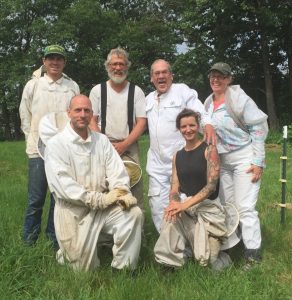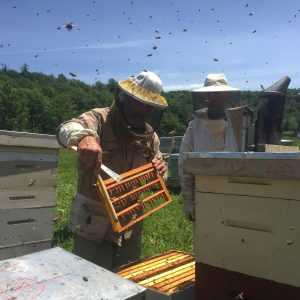Kirk Webster: Looking “Organically” at the Broader Landscape of Bee Health

When Kirk Webster finished high school in Vermont, he got into a toboggan accident that winter and while he was “moping around,” as he says, someone gave him “this little book about bees and beekeeping.” That spring he went back to the Mountain School in Vershire, Vermont and then to visit family in New Jersey where he met Myron Surmach, a beekeeper with about 30 hives at his house. And that’s how Kirk’s interest in beekeeping really sparked.
“I worked right here near where I live now with the Champlain Valley Apiaries,” says Kirk. “And I worked in Canada and Ontario for a beekeeper there, but then I was injured in that accident and my back was hurt pretty badly and I couldn’t do the heavy lifting of beekeeping.”
He took a little break and then ended up going to school on the West Coast and three years later, when he recovered and could do physical work again, he moved back to the East Coast and ended up in Concord, Massachusetts, where he started the apiary he has now. That was in the early ‘80s. Here he happened upon a few neglected beehives and volunteered to take care of them and the bees did really well, which rekindled his interest. Kirk’s beekeeping business started in Massachusetts and stayed there for four years, until he moved back up to Vermont.
Since Kirk became a full-time beekeeper, he’s operated under the landscape of the problem. His response to the crisis was different than most. Before becoming a beekeeper, he had a lot of exposure to organic farming and by “sheer serendipity” he met some of the “very first pioneers of the organic farming movement in North America who in turn had been inspired by the pioneers of organic farming in England.” In one way or another, Kirk tried to apply those sample principles to his beekeeping.
Kirk remembers a time when the American beekeeping community “used to be the one part of the agricultural community that was uniformly opposed to the pesticides and agricultural chemicals.” And then what felt to him “just like overnight, the beekeeping community became dependent on pesticides [because of the whole varroa mite problem].”
While Kirk’s methods seemed unconventional to some at first, he says he’s always tried to share any progress he’s made with the greater beekeeping community and the public, mostly through his writing. An unexpected side to the introduction of the varroa mite problem is that there are “grants out there in the millions” for honey bee research because “people realize the threat to our food supply,” says Kirk. “They really do care about the bees and being better,” but it’s a tough situation to be in because the agricultural science community is “really oriented around industrial agriculture and largely funded by it.” And often without any “huge interpretation by science,” any advice offered outside of the “official people who are paid to solve these problems…doesn’t look very good for them when people living in a barn somewhere in New England figure out a good solution.”
Much like Jasmine Joy, Kirk emphasizes the importance of focusing on the health of the bees. Kirk sees the “real existential threats to beekeeping [as] the poisoning of the environment and the loss of habitat for honey bees.” Looking at this broader picture, it “doesn’t matter how successful people are breeding bees that can coexist with varroa mites if the environment bees are living in [is] becoming more and more poisonous to them.”
Kirk has always gone the treatment-free method with his bees and he encourages new beekeepers to do the same, if they can. In addition to knowledge sharing, Kirk offers an eight-day workshop to a small group of folks to learn about the whole queen rearing cycle. Much like Jasmine, Kirk suggests new beekeepers find a good mentor and start off with more than one colony, especially because “almost nobody succeeds in keeping all their colonies alive every year.”
“Irrespective of what kind of stock you might have, just learning the basic process…the opportunities and possibilities from making your own new colonies…[goes a] really really long way toward…making sure you can have success,” says Kirk. He continues, “Splitting colonies and making new ones is helpful to both the parent colony and the new colonies in terms of their mite populations.” This practice enables you to take advantage of certain opportunities, like if you want to try a different stock from someone else.
Kirk recommends for any beekeeper, hobby or commercial, that producing their own replacement colonies is a crucial step. And if you end up with extra colonies you don’t need, “there’s just so many people in the Northeast who want bees and can’t get local bees,” that you could sell them or give them and “help out the community that way,” advises Kirk.

While Kirk goes treatment-free in his hives, he sees the frustration in the blanket advice of going treatment free for everyone especially for those beekeepers who only have one location. “Any queens that you raise will mate with other bees around you,” says Kirk and, “most of those bees are being treated…and haven’t been selected for mite resistance.” So, that’s definitely a challenge.
Kirk believes the “best thing any of us can do to help honey bees is to encourage and support organic farming any way that we can” because “the difference between organic farming and industrial agriculture is just like night and day for the bees.”
“We have to plant flowers along the road,” says Kirk and “when you start to have whole farms that are clean and healthy for the bees, that provides that much even if it’s not providing their entire foraging area.”
In general, Kirk sees a need to utilize honey bees as “indicators of the total health of an environment. So, I think we should focus more on that.”
Media Attributions
- Kirk Webster © Ang Roell is licensed under a CC BY-NC (Attribution NonCommercial) license
- Kirk Webster and beehive © Ang Roell is licensed under a CC BY-NC (Attribution NonCommercial) license
Varroa destructor (Varroa mite) is an external parasitic mite that attack and feeds on the honey bees Apis cerana and Apis mellifera. The disease caused by the mites is called varroosis. The Varroa mite can only reproduce in a honey bee colony.


Feedback/Errata